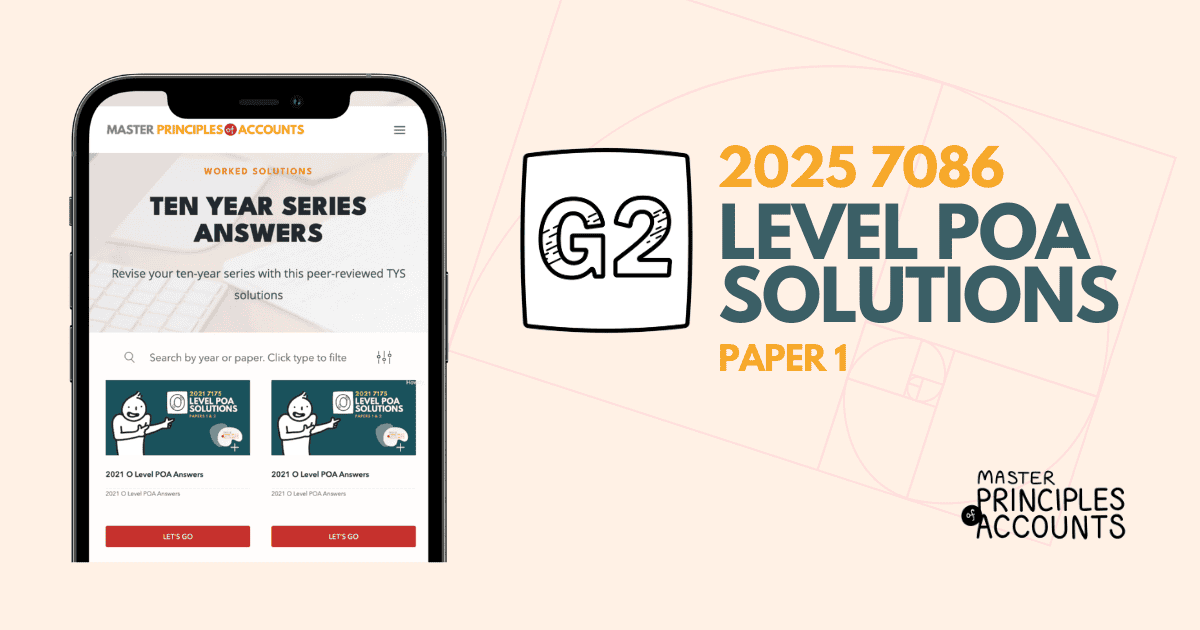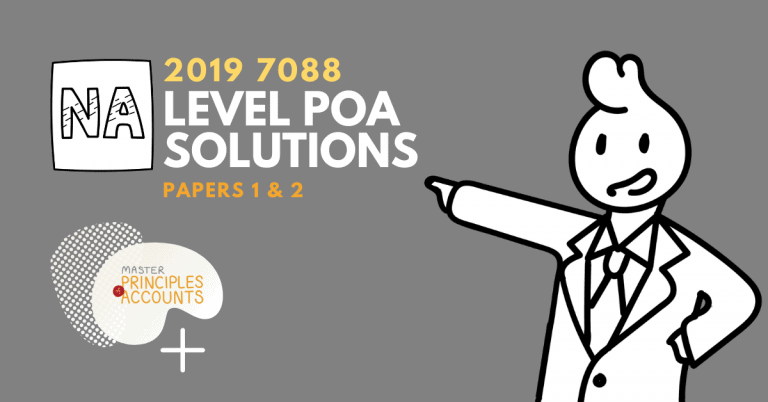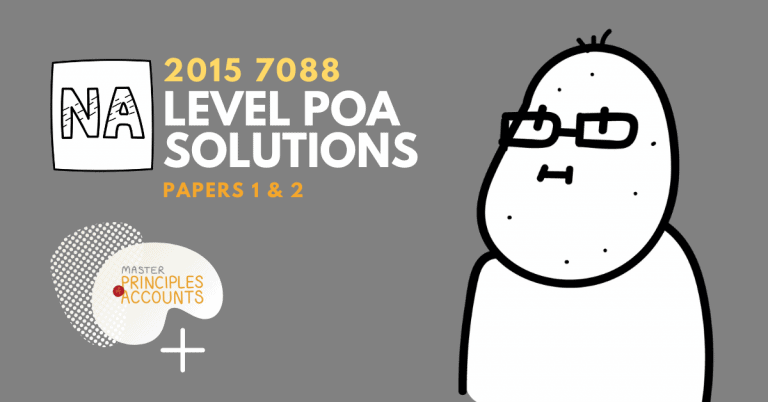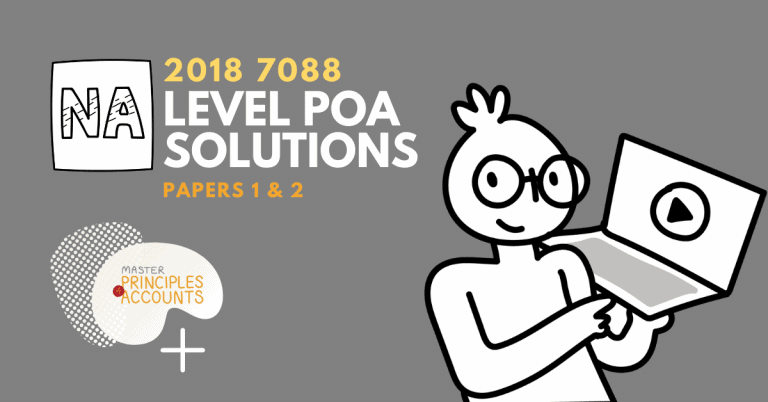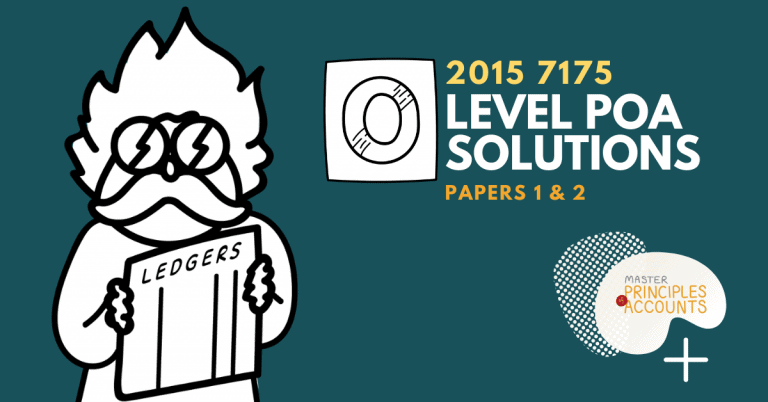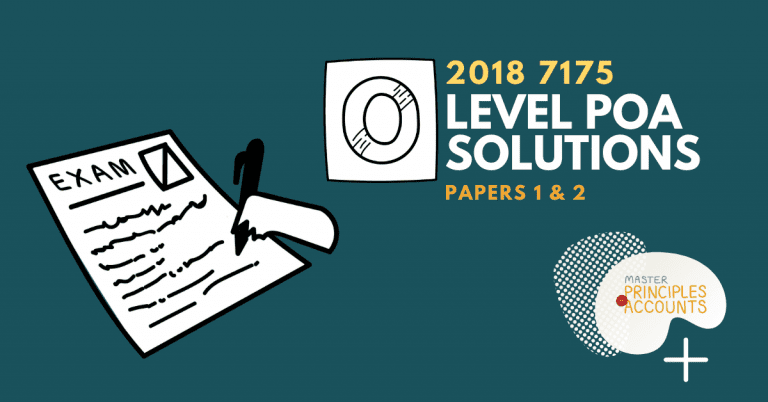2025 G2 N Level POA Answers
Paper 1
(a) Explain the difference between how a trading business and a service business earns revenue.
- A trading business earns revenue primarily from the purchase and sale of goods. [1]
- A service business earns revenue from providing services or skills to customers. [1] Total: [2]
b) Complete the table by placing a tick (✓) in the appropriate column to indicate the type of business each of the following applies to:
| Trading business only | Service business only | Both trading and service businesses | Marks | |
| Profit for the year | ✓ | [1] | ||
| Gross profit | ✓ | [1] | ||
| Cost of sales | ✓ | [1] | ||
| Total | [3] |
(c) Prepare journal entries to record transactions 1, 2 and 3. Narrations are not required.
| Particulars | Debit ($) | Credit ($) | Marks | |
| 1 | Cash at bank | 4,000 | [1] | |
| Capital | 4,000 | [1] | ||
| 2 | Rent expense | 2,000 | [1] | |
| Cash at bank | 2,000 | [1] | ||
| 3 | Fixtures and fittings | 1,200 | [1] | |
| Trade Payable – MVL | 1,200 | [1] | ||
| [6] |
Question 2
(a) Complete the following table by identifying in which sub-section of the statement of financial position each item is recorded.
| Item | Sub-section of the statement of financial position | Marks |
| Bank overdraft | Current liabilities | (Given) |
| Office equipment | Non-current assets | [1] |
| Capital | Owner’s equity (or Equity) | [1] |
| Trade payables | Current liabilities | [1] |
| Inventory | Current assets | [1] |
| Expenses payable | Current liabilities | [1] |
| Total | [5] |
(b) Identify whether the following transactions are capital expenditure or revenue expenditure.
| Transaction | Classification | Marks |
| 1. Purchase of computers, $6000. | Capital expenditure | [1] |
| 2. Installation of computers, $1800. | Capital expenditure | [1] |
| 3. Training for employees to operate the computers, $600. | Revenue expenditure | [1] |
| 4. Insurance for the computers, $730. | Revenue expenditure | [1] |
| Total | [4] |
(a) Interpret the entries in the Allowance for impairment of trade receivables account.
| Date | Interpretation | Marks |
| (i) 2 March 2024 | A debt of $1,000 from credit customer Anwar was deemed irrecoverable / bad. This amount was written off against the existing allowance for impairment. | [1] |
| (ii) 31 December 2024 | The allowance for impairment of trade receivables was increased by $6,200 at the year-end. This represents the impairment loss (expense) for the year. | [1] |
(b) Prepare an extract of the statement of financial position as at 31 December 2024, to show the presentation of trade receivables and the allowance for impairment.
| Extract of Statement of Financial Position as at 31 December 2024 | $ | $ | Marks |
| Current Assets | |||
| Trade receivables | 124,000 | [1] | |
| Less: Allowance for impairment of trade receivables | (10,000) | 114,000 | [2] |
c) Credit Worthiness & Accounting Theory
d) State two non-accounting sources of information which should be considered when assessing the credit worthiness of trade receivables.
- Any two of the following:
- Credit reports from credit bureaus
- Bank references.
- General economic conditions.
- Reputation of the customer in the industry.
- Number of years the customer has been in business.
[1] mark for each valid source
Total: [2]
(d) State one accounting theory used when accounting for impairment loss on trade receivables.Prudence or Matching Theory Total: [1]
(a) Calculate the rent income to be transferred to the income summary for the year ended 31 December 2024.
- Rent income = Rent received in advance + Rent received and banked + Rent income receivable
- Rent income = $4,800 [1] + $56,300 [1] + $1,200 [1] = $62,300 Total: [3]
(b) Explain the revenue recognition theory.
- Revenue is recognised/recorded when it is earned [1], regardless of when the cash is received [1]. Total: [2]
(c) Calculate the profit for the year ended 31 December 2024.
- Total Revenue = Service fee revenue + Rent income
= $185,420 + $62,300 = $247,720 [1] - Profit for the year = Total Revenue – Other expenses
= $247,720 – $39,700 = $208,020 [1] Total: [2]
(d) State two causes of a dishonoured cheque.
- Any two of the following:
- Insufficient funds in the drawer’s account.
- Signature on cheque differs from bank’s records.
- Amount in words and figures do not match.
- Cheque is post-dated / stale.
- Alterations on the cheque are not countersigned.
- Drawer has issued a stop payment order.
- [1] mark for each valid cause. Total: [2]
(e) State one account which is credited when a dishonoured cheque is recorded.
- Bank (or Cash at Bank) Total: [1]
Paper 2
(a) Prepare the statement of financial performance for the year ended 30 June 2025.
| Ethan | ||
| Statement of Financial Performance for the year ended 30 June 2025 | $ | $ |
| Sales revenue | 348,000 | |
| Less: Sales returns | (2,400) | |
| Net sales revenue | 345,600 | |
| Less: Cost of sales | (140,000) | |
| Gross Profit | 205,600 | |
| Add: Other income | ||
| Commission income ($4,300 + $200) | 4,500 | |
| 210,100 | ||
| Less: Other Expenses | ||
| Office Expenses ($12,800 – $300) | 12,500 | |
| Wages and salaries | 42,500 | |
| Motor vehicle expenses | 19,600 | |
| Depreciation of property (5% x $280,000) | 14,000* | |
| Depreciation of motor vehicles (20% x [$34,000 – $6,800]) | 5,440 | |
| Impairment loss on trade receivables (reversal) ($1,450 – $1,600) | (150) | |
| (93,890) | ||
| Profit for the year | 116,210 |
[10 marks]
Note: Marks would be awarded based on the ‘own figure rule’ / ‘error carried forward’ principle in the subsequent part.
(b) Prepare the statement of financial position as at 30 June 2025.
| Ethan Statement of Financial Position as at 30 June 2025 | |||
| Cost ($) | Accumulated Depreciation ($) | Net Book Value ($) | |
| ASSETS | |||
| Non-current assets | |||
| Property (28000+14000) | 280,000 | (42,000) | 238,000 |
| Motor Vehicles | 34,000 | (12,240) | 21,760 |
| 259,760 | |||
| Current assets | |||
| Inventory | 8,900 | ||
| Trade receivables | 29,000 | ||
| Less: Allowance for impairment on TR | (1,450) | 27,550 | |
| Prepaid office expenses | 300 | ||
| Commission income receivable | 200 | ||
| Cash in hand | 825 | ||
| 37,775 | |||
| Total assets | 297,535 | ||
| EQUITY & LIABILITIES | |||
| Owner’s equity | |||
| Capital (200000+116210-42000) | 274,210* | ||
| Current liabilities | |||
| Bank overdraft | 1,300 | ||
| Trade payables | 22,025 | ||
| 23,325 | |||
| Total equity and liabilities | 274,535 | ||
[10 marks]
Note: Candidate’s capital is calculated using their profit figure of $128,810 (e.g., $200,000 – $42,000 + $128,810 = $286,810). This is acceptable under the ‘own figure rule’. The correct capital figure would be $200,000 – $42,000 + $116,210 = $274,210.
(a) State two stakeholders who may have an interest in a business.
- Any two of the following: Owner, Employees, Customers, Suppliers, Government, Bank/Lenders, Community. [2 marks]
(b) State the double entry to record each transaction.
| Transaction | Account to be debited | Account to be credited |
| 1 | Cash at bank | Bank loan |
| 2 | Office equipment | Trade payable |
| 3 | Cash at bank | Cash in hand |
| 4 | Drawings | Cash in hand |
| 5 | Cash at bank | Trade receivable |
[2 marks for each correct row, total 10 marks]
(c) Identify the source documents needed for each purpose.
| Purpose | Source document |
| Informs customers of the amount due for sale of goods or services on credit. | Invoice |
| Reduces the amount owed by credit customers. | Credit note |
[1 mark for each, total 2 marks]
(a) Update the cash at bank account as at 31 August 2025.
Cash at bank (updated)
| Date | Particulars | Debit ($) | Credit ($) | Balance ($) |
| 2025 | ||||
| Aug 31 | Balance b/d | 5,720 Dr | ||
| Aug 31 | D Shaw | 120 | 5,600 Dr | |
| Aug 31 | Poughty | 320 | 5,920 Dr | |
| Aug 31 | Interest | 10 | 5,930 Dr | |
| Sep 1 | Balance b/d | 5,930 Dr |
[4 marks]
(b) Prepare the bank reconciliation statement as at 31 August 2025.
| Bank Reconciliation Statement as at 31 August 2025 | $ | $ |
| Balance as per bank statement | 4,435 | |
| Add: Deposits in transit / Uncredited deposits | 2,000 | |
| 6,435 | ||
| Less: Cheques not yet presented / Unpresented cheques | ||
| Inventory | 80 | |
| Rent | 425 | (505) |
| Balance as per updated cash at bank account | 5,930 |
[5 marks]
(c) State two internal controls over cash.
- Any two of the following: Segregation of duties (e.g., between cashier and bookkeeper), Regular bank reconciliations, Use of cash registers, Depositing all cash receipts into the bank daily, Making payments by cheque or bank transfer instead of cash. [2 marks]
(d) Explain the monetary theory.
Only business transactions that can be measured and expressed in monetary terms (e.g., dollars and cents) are recorded in the accounting books. [2 marks]
(a) Prepare the inventory account for the month of April 2025.
| Date | Particulars | Debit ($) | Credit ($) | Balance ($) |
| 2025 | ||||
| Apr 1 | Balance b/d | 300 Dr | ||
| Apr 4 | Trade payable – Speedy | 160 | 460 Dr | |
| Apr 21 | Trade payable – Speedy | 240 | 700 Dr | |
| Apr 22 | Cost of sales | 460 | 240 Dr | |
| Apr 27 | Trade payable – Speedy | 600 | 840 Dr | |
| May 1 | Balance b/d | 840 Dr |
[6 marks]
(b) State one reason for a business to keep inventories.
- To meet customer demand promptly / To avoid losing sales due to stock-outs. [1 mark]
(c) Name the accounting theory used in the valuation of inventory.
- Prudence theory / concept. [1 mark]
(d) Advise Sophia which product her business should choose. Justify your decision with two reasons.
- Either choice is acceptable with valid justification. Example answers:
Choice: Photon
- Reason 1: It has a lower cost per can ($1 vs $3), which could lead to a higher gross profit margin.
- Reason 2: It can be stored at any temperature, saving the business the cost of purchasing and running refrigeration units.
- Reason 3: Association with a popular sportswear brand could attract customers and boost sales without significant marketing effort.
Choice: Kinetic
- Reason 1: It contains natural sugar, which appeals to health-conscious consumers, a growing market segment.
- Reason 2: The environmentally friendly processing can be used as a marketing tool to attract customers who prioritize sustainability.
[1 mark for choice, 2 marks for each valid reason, total 5 marks]

